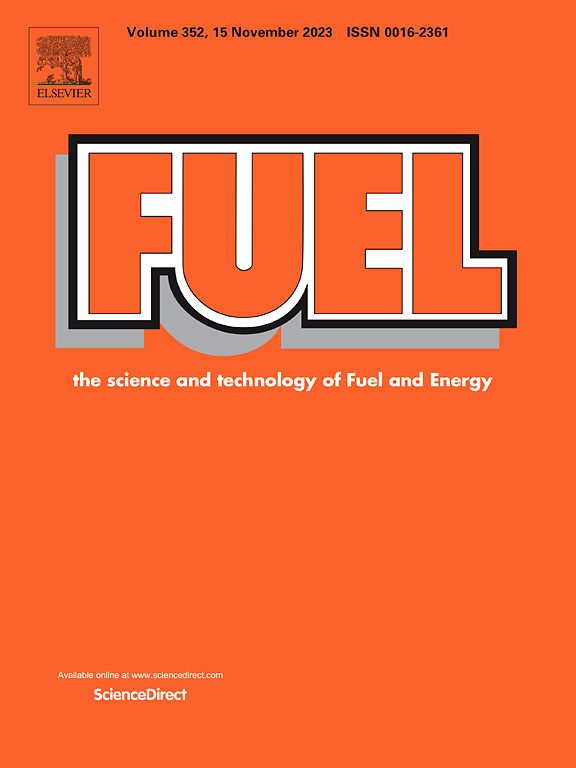了解SrCO3/SrO热化学储能中H2促进SrCO3分解的机理
IF 7.5
1区 工程技术
Q2 ENERGY & FUELS
引用次数: 0
摘要
SrCO3/SrO热化学储能技术是一项很有前途的技术。SrCO3分解过程中高温引起的锶基材料烧结是该技术面临的主要挑战。本文提出了一种利用H2促进SrCO3分解,将CO2转化与SrCO3/SrO热化学储能相结合的新方法。实验结果表明,在900 ℃时,SrCO3在H2气氛下的最大分解速率是N2气氛下的10倍。在600 s内,H2气氛下SrCO3的转化率是N2气氛下的23倍。此外,CO的选择性超过93 %。密度泛函理论计算表明,H2促进SrCO3分解的最佳反应途径是HCO3 -一步分解。电子密度差分析表明,H原子在CO32 -上的吸附削弱了C-O键,有效降低了反应能垒。在H2解离过程中,锶基材料的活性位点由于对H2的物理吸附而不能有效催化反应。这使得该元素反应具有4.65 eV的高能垒,从而成为H2促进SrCO3分解过程中决定速率的元素反应。与直接分解相比,H2促进SrCO3分解使速率势垒降低了16.1 %。此外,SrO对H2促进的SrCO3分解反应表现出自催化作用。该研究为SrCO3/SrO热化学储能系统的优化提供了一种新的策略,并为进一步的开发提供了理论基础。本文章由计算机程序翻译,如有差异,请以英文原文为准。
Understanding the mechanism of H2 promoted SrCO3 decomposition in SrCO3/SrO thermochemical energy storage
SrCO3/SrO thermochemical energy storage is a promising technology. The sintering of strontium-based materials caused by the high temperature during SrCO3 decomposition is the major challenge for this technology. Herein, a novel method that integrates CO2 conversion and SrCO3/SrO thermochemical energy storage by using H2 to promote SrCO3 decomposition was proposed. Experimental results show that at 900 °C, the maximum decomposition rate of SrCO3 in the H2 atmosphere is 10 times higher than that in the N2 atmosphere. Within 600 s, the conversion of SrCO3 in the H2 atmosphere is 23 times higher than that in the N2 atmosphere. Additionally, the selectivity of CO exceeds 93 %. Density functional theory calculations reveal that the optimal reaction pathway for H2 promoted SrCO3 decomposition is the one-step decomposition of HCO3–. Electronic density difference analysis shows that H atom adsorption on CO32– weakens the C–O bonds, effectively decreasing the reaction energy barrier. During the H2 dissociation process, active sites of the strontium-based material could not catalyze the reaction effectively because of the physical adsorption of H2. This results in a high energy barrier of 4.65 eV for this elementary reaction, which thus becomes the rate-determining elementary reaction in the H2 promoted SrCO3 decomposition process. Compared with direct decomposition, H2 promoted SrCO3 decomposition reduces the rate-determining energy barrier by 16.1 %. Besides, SrO exhibits a self-catalytic effect on the H2 promoted SrCO3 decomposition reaction. This study provides a novel strategy for optimizing SrCO3/SrO thermochemical energy storage systems and offers a theoretical basis for further development.
求助全文
通过发布文献求助,成功后即可免费获取论文全文。
去求助
来源期刊

Fuel
工程技术-工程:化工
CiteScore
12.80
自引率
20.30%
发文量
3506
审稿时长
64 days
期刊介绍:
The exploration of energy sources remains a critical matter of study. For the past nine decades, fuel has consistently held the forefront in primary research efforts within the field of energy science. This area of investigation encompasses a wide range of subjects, with a particular emphasis on emerging concerns like environmental factors and pollution.
 求助内容:
求助内容: 应助结果提醒方式:
应助结果提醒方式:


